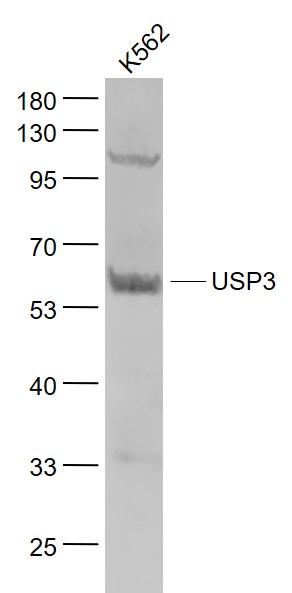USP3 Rabbit pAb
USP3 Rabbit pAb
- 产品详情
- 实验流程
- 背景知识
Application
| WB |
|---|---|
| Primary Accession | Q9Y6I4 |
| Reactivity | Human |
| Host | Rabbit |
| Clonality | Polyclonal |
| Calculated MW | 58897 Da |
| Physical State | Liquid |
| Immunogen | KLH conjugated synthetic peptide derived from human USP3 |
| Epitope Specificity | 31-130/520 |
| Isotype | IgG |
| Purity | affinity purified by Protein A |
| Buffer | 0.01M TBS (pH7.4) with 1% BSA, 0.02% Proclin300 and 50% Glycerol. |
| SUBCELLULAR LOCATION | Nucleus. Localizes preferentially with monoubiquitinated H2A to chromatin. |
| SIMILARITY | Belongs to the peptidase C19 family. USP3 subfamily.Contains 1 UBP-type zinc finger. |
| SUBUNIT | Interacts (via UBP-type domain) with H2A; the interaction is less efficient than with monoubiquitinated H2A. |
| Important Note | This product as supplied is intended for research use only, not for use in human, therapeutic or diagnostic applications. |
| Background Descriptions | The ubiquitin (Ub) pathway involves three sequential enzymatic steps that facilitate the conjugation of Ub and Ub-like molecules to specific protein substrates. Through the use of a wide range of enzymes that can add or remove ubiquitin, the Ub pathway controls many intracellular processes such as signal transduction, transcriptional activation and cell cycle progression. USP3 (ubiquitin specific peptidase 3), also known as UBP or SIH003, is a 520 amino acid protein that contains one UBP-type zinc finger and belongs to the peptidase C19 family. Expressed ubiquitously with highest levels present in pancreas, USP3 catalyzes the conversion of a ubiquitin C-terminal thioester to a free ubiquitin and a thiol. The gene encoding USP3 maps to human chromosome 15, which houses over 700 genes and comprises nearly 3% of the human genome. |
| Gene ID | 9960 |
|---|---|
| Other Names | Ubiquitin carboxyl-terminal hydrolase 3, 3.4.19.12, Deubiquitinating enzyme 3, Ubiquitin thioesterase 3, Ubiquitin-specific-processing protease 3, USP3 |
| Target/Specificity | Expressed in all tissues examined, with strongest expression in pancreas. |
| Dilution | WB=1:500-2000 |
| Storage | Store at -20 °C for one year. Avoid repeated freeze/thaw cycles. When reconstituted in sterile pH 7.4 0.01M PBS or diluent of antibody the antibody is stable for at least two weeks at 2-4 °C. |
| Name | USP3 |
|---|---|
| Function | Deubiquitinase that plays a role in several cellular processes including transcriptional regulation, cell cycle progression or innate immunity. In response to DNA damage, deubiquitinates monoubiquitinated target proteins such as histone H2A and H2AX and thereby counteracts RNF168- and RNF8-mediated ubiquitination. In turn, participates in the recruitment of DNA damage repair factors to DNA break sites (PubMed:24196443). Required for proper progression through S phase and subsequent mitotic entry (PubMed:17980597). Acts as a positive regulator of TP53 by deubiquitinating and stabilizing it to promote normal cell proliferation and transformation (PubMed:28807825). Participates in establishing tolerance innate immune memory through non-transcriptional feedback. Mechanistically, negatively regulates TLR-induced NF-kappa-B signaling by targeting and removing the 'Lys- 63'-linked polyubiquitin chains on MYD88 (PubMed:37971847). Negatively regulates the activation of type I interferon signaling by mediating 'Lys-63'-linked polyubiquitin chains on RIGI and IFIH1 (PubMed:24366338). Also deubiquinates ASC/PYCARD, the central adapter mediating the assembly and activation of most inflammasomes, and thereby promotes inflammasome activation (PubMed:36050480). |
| Cellular Location | Nucleus. Cytoplasm. Note=Localizes preferentially with monoubiquitinated H2A to chromatin (PubMed:17980597). Upon NF-kappa-B signaling activation, exits the nucleus (PubMed:37971847) |
| Tissue Location | Expressed in all tissues examined, with strongest expression in pancreas |
For Research Use Only. Not For Use In Diagnostic Procedures.
Provided below are standard protocols that you may find useful for product applications.
BACKGROUND
The ubiquitin (Ub) pathway involves three sequential enzymatic steps that facilitate the conjugation of Ub and Ub-like molecules to specific protein substrates. Through the use of a wide range of enzymes that can add or remove ubiquitin, the Ub pathway controls many intracellular processes such as signal transduction, transcriptional activation and cell cycle progression. USP3 (ubiquitin specific peptidase 3), also known as UBP or SIH003, is a 520 amino acid protein that contains one UBP-type zinc finger and belongs to the peptidase C19 family. Expressed ubiquitously with highest levels present in pancreas, USP3 catalyzes the conversion of a ubiquitin C-terminal thioester to a free ubiquitin and a thiol. The gene encoding USP3 maps to human chromosome 15, which houses over 700 genes and comprises nearly 3% of the human genome.
终于等到您。ABCEPTA(百远生物)抗体产品。
点击下方“我要评价 ”按钮提交您的反馈信息,您的反馈和评价是我们最宝贵的财富之一,
我们将在1-3个工作日内处理您的反馈信息。
如有疑问,联系:0512-88856768 tech-china@abcepta.com.























 癌症的基本特征包括细胞增殖、血管生成、迁移、凋亡逃避机制和细胞永生等。找到癌症发生过程中这些通路的关键标记物和对应的抗体用于检测至关重要。
癌症的基本特征包括细胞增殖、血管生成、迁移、凋亡逃避机制和细胞永生等。找到癌症发生过程中这些通路的关键标记物和对应的抗体用于检测至关重要。 为您推荐一个泛素化位点预测神器——泛素化分析工具,可以为您的蛋白的泛素化位点作出预测和评分。
为您推荐一个泛素化位点预测神器——泛素化分析工具,可以为您的蛋白的泛素化位点作出预测和评分。 细胞自噬受体图形绘图工具为你的蛋白的细胞受体结合位点作出预测和评分,识别结合到自噬通路中的蛋白是非常重要的,便于让我们理解自噬在正常生理、病理过程中的作用,如发育、细胞分化、神经退化性疾病、压力条件下、感染和癌症。
细胞自噬受体图形绘图工具为你的蛋白的细胞受体结合位点作出预测和评分,识别结合到自噬通路中的蛋白是非常重要的,便于让我们理解自噬在正常生理、病理过程中的作用,如发育、细胞分化、神经退化性疾病、压力条件下、感染和癌症。






